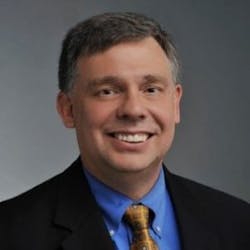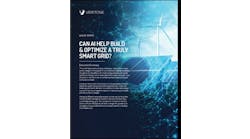In this edition of Industry Perspectives, Siemens’ Clark Wiedetz and other company experts explore the ins and outs of campus microgrids, as well as answers to some of the most-asked questions from universities and colleges on microgrid development and value.
Clark Wiedetz, microgrid and renewable integration director for Siemens Energy Management
Together with Christopher Kopach from the Association of Physical Plant Administrators (APPA) and Henry Mignardot, Executive Director of Plant & Operations Management from Santa Fe Community College (SFCC), Siemens Digital Grid participated in an informative webinar in late February to discuss SFCC’s energy management evolution from nanogrid to campus-wide microgrid.
The webinar produced dozens of questions from university plant administrators for both SFCC and Siemens. Here is a sample of the more relevant questions on campus microgrids and excerpts of their answers:
Q1: Henry, where are you in reducing the carbon footprint at SFCC and what are your projected plans to get to neutral?
HM: It has definitely been a challenge to understand our on-campus energy assets because our college has accumulated these assets over the past 35 years. Therefore, it is really important to analyze, understand, and ultimately audit all of these assets. Reducing our carbon footprint has been a goal of not only our students, but also our campus and president. We first worked to achieve this goal by implementing and installing a bio-fuels boiler – we have a 1M BTU wood chip boiler on campus, which we have been using for the past 10 years. Since then, we now have a 1.5 MW PV array, 12kV array system, and a 450kV PV array system on rooftop plus parking lot. Our carbon footprint for our main campus has since been reduced by ~45 percent; we are close to getting it down by half.
Q2: Henry, how did you get your president and senior administration on board?
HM: It is a process of identifying to your colleagues the energy costs for your college, which on a side note are ~25 percent of my operating budget for my plant. We literally analyzed the cost of energy-per-student and compared it with our utility costs (e.g., energy, water, waste, etc.). We used this ratio to not only show what each student is paying with respect to tuition fees, but also how that cost could be better managed to the extent that we could combine energy resources into a single controllable entity, like a microgrid system, and start managing those assets to reduce our peak load and energy consumption. When we enlightened all of our team, including the president, with these aspects, they all listened to our suggestions.
Microgrids utilize local generation that can be distributed efficiently among several buildings located within a discrete geographic footprint.
Q3: What sort of analytics should we be looking at to paint a better picture for our college administration team?
CW: It is amazing to see where opportunities are applicable to utilize advanced controls. Siemens sees areas of opportunity with clients who have as little as $0.05 power because these clients still care about reliability, as an example. Facilities want or need to have backup power in case of emergencies. Additionally, the ability to optimize existing distributed generation assets using an advanced control system can definitely save you money, even if you are at $0.05 power.
HM: Let me just add that it is extremely important as a physical plant manager to understand energy and utility costs because you need to know how much you are spending in order to reduce these costs. Once these energy assets are understood, audited, and analyzed, then when you bring them onto a management system, you can more easily manage your loads and control your energy costs.
[clickToTweet tweet=”Microgrids and campuses are a natural fit, which is a big reason why colleges and universities are apt to embrace them. #microgrids” quote=”Microgrids and campuses are a natural fit, which is a big reason why colleges and universities are apt to embrace them. #microgrids”]
Q4: Can you elaborate on utilizing smart building controls to drive down operating costs?
CW: This is a great question that gets back to objectives in terms of capabilities and functionalities. We only talked about the generation/microgrid part on today’s webinar, but SFCC is also working with our sister division – Siemens Building Technologies – to integrate other building management systems for improvements within the various buildings on campus. These are two systems working together both inside and outside the building, so to speak. By the question, it looks like you are still at the planning stage, so I encourage you to figure-out what you actually want to accomplish. If that can be done through a building management system, then great because you might already have one in place today that can be upgraded to accommodate your needs. However, if that means adding an inexpensive advanced control system, we can help you figure-out that as well.
In summary, microgrids and campuses are a natural fit, which is a big reason why colleges and universities are apt to embrace them. First, microgrids provide students with hands-on training using real-world technology used by many private and public utilities to operate the nation’s power grid to manage alternative, renewable, and distributed energy resources becoming increasingly prevalent across US power systems. Microgrids utilize local generation that can be distributed efficiently among several buildings located within a discrete geographic footprint. Furthermore, campus microgrids offer a road to good management of an institution’s energy budget. Governed by highly intelligent controls software, microgrids can be programmed to provide the most efficient, least cost energy first. Lastly, microgrids can offer potential revenue opportunities – e.g., by selling services back to the electric grid, such as capacity or grid balancing.
Clark Wiedetz is director of microgrids and renewable integration at Siemens Digital Grid.








